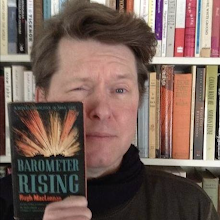Do Evil in Return
Margaret Millar
New York: Dell [1951]
Two men are in love with Charlotte Keating. It's easy to see why. Beautiful, intelligent, confident and caring, Charlotte is the complete package. She has her own medical practice and just last year bought an expansive house complete with sweeping city and harbour views of Salinda, California. Gossipy Nurse Schiller doesn't think much of Dr Keating's after-hours attire – picture hats, sheer dresses and high-heeled pumps – but that's just jealousy speaking.
The real black mark against Charlotte is found in the form of married lawyer Lewis Ballard. You can't quite accuse them of running around; they're far too discrete. They spend most of their time together at Charlotte's house. He parks himself in a large leather chair as she stands staring out her large living room picture window at the lights below. The bedroom doesn't come into play. One year in, they've yet to consummate their relationship.
Sex enters the novel on the first page when young Violet O'Gorman arrives at Charlotte's practice. Four months pregnant by a man who is not her estranged brute of a husband, she's desperate and lays it all out on the line:
"I – oh, doctor, please. You've got to help me."
"I'm sorry I can't, not in the way you mean."
The girl let out a cry of despair. "I thought – I thought being you was a woman like me – being you –"
"I'm sorry," Charlotte said again.
"What can I do? What can I do with this – this thing growing inside of me, growing and growing, and me with no money and no job and no husband. Oh, God, I wish I was dead!" She struck her thighs with both fists. "I'll kill myself!"
"You can't, Violet. Stop now and be sensible."
Words of a woman who by all appearances has always had it together to a woman whose life is in chaos. It's an interesting part of the novel in that there is a subtle implication that Charlotte does indeed perform abortions, but is trying to be cautious. The first mystery here is just how Violet, a girl from Ashley, Oregon, ended up in her Southern California office. Charlotte is trying to get at the answer when Lewis phones and Violet bolts.
Charlotte isn't really so concerned about the mystery as she is about Violet; her evening with Lewis is ruined as a result. After he returns home to his wife, she visits the address Violet gave Nurse Schiller to find the girl missing. Step-uncle Clarence Voss tells Charlotte that his niece must've gone to a movie or something. It's all very suspicious.
Violet's body is washed ashore the next day. Lieutenant Easter, the detective assigned to the case, tells Charlotte that the girl was a suicide, though you never quite feel he believes it.
This reader didn't believe it. I was certain Violet didn't kill herself if only because I knew that
Do Evil in Return followed
Experiment in Springtime (1947),
It's All in the Family (1948) and
The Cannibal Heart (1949), marking Millar's return to writing mysteries.
You'd think she'd never been away.
Do Evil in Return ranks amongst Millar's best novels, which is to say that it is just a hair's breath above the average Millar novel. She was that consistent. Scenes stay, as do the characters. It says much about her talent that one of the most fully drawn examples of the latter is an inessential figure we meet just twice: Roy H. Coombs, a pudgy motel manager who finds escape in reading romance comic books of the sort aimed at teenage girls.
On the subject of romance, Lieutenant Easter follows Lewis as the second man to fall for Charlotte. His aggressive pursuit of the doctor would be deemed inappropriate and unprofessional today.
Times change.
For the life of me, I couldn't understand how it was that so attractive a woman as Charlotte hadn't been able to find a mate. My wife suggests that the post-war male might have found her intelligence, her confidence and her independence intimidating.
Times change.
Poor Violet.
Object: A 192-page classic Dell, complete with map back. The cover is by Bill Fleming, the artist who will always be remembered for this:
I'm not sure what to think of his illustration for
Do Evil in Return. Does it not look like poor Violet has a beard?
Access: Only eight of our university libraries hold copies. Library and Archives Canada also has one, as does the public library in Kitchener, the author's hometown.
Do Evil in Return was first published by Random House in 1950, with paperbacks from Dell, Lancer and Avon following. Paired with my favourite Margaret Millar novel,
An Air That Kills, it was last published ten years ago by Stark House. Syndicate Books is rereleasing
Do Evil in Return as an ebook next month.
As with most Millars,
Do Evil in Return has enjoyed a number of translations: French (
Rendons le mal pour le mal), German (
Wie du mir), Italian (
Inganno per quattro), Spanish (
Pagarás con maldad), Finnish (
Pahan valta) and Japanese (悪意の糸). Google translates the Polish title,
Pięknym za nadobne as
Tit for Tat.
Related post:



